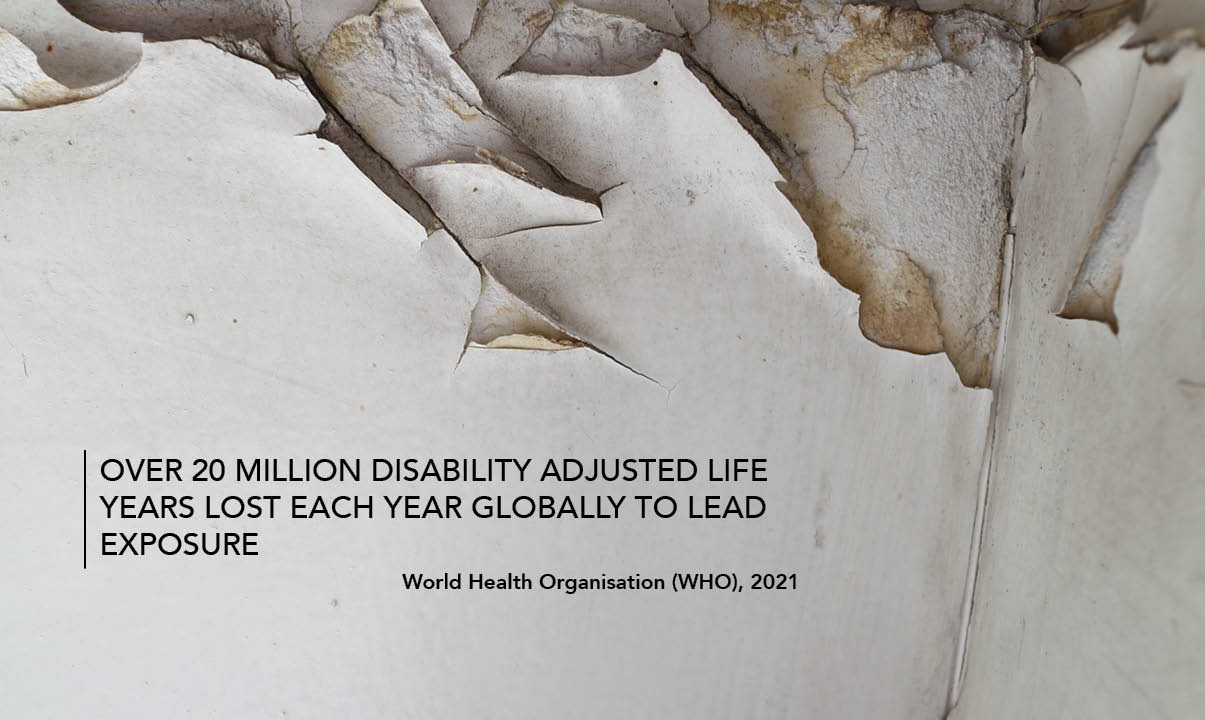Over 20 Million Years Lost Each Year Globally To Lead Exposure
14 November 2022
According to the World Health Organisation’s (WHO) 2021 Public health impact of chemicals: knowns and unknowns, lead exposure is estimated to account for 21.7 million years lost to disability and death (disability-adjusted life years, or DALYs) worldwide in 2019.
In the 20th century, lead was added to many materials for a number of reasons but in particular to paints to be used on a variety of different surfaces to give a hard-wearing finish. It was used as gloss and primer paints on exterior metals and woods up until the 1960s. The addition of lead accelerated the drying rate of the paint, and its durability resisted corrosion, making it a popular product to use both in domestic and non-domestic buildings.
In 1992 the UK Department for Environment, Food and Rural Affairs (DEFRA) implemented the ban on the use of lead in most paints. Larne Fuller, Area Director for Lucion Services, discusses the key things to consider when testing for lead and why lead paint testing should be considered at the same time you are undertaking asbestos surveys and other hazardous materials testing.
Lead is a toxic metal that can cause serious health problems if it is inhaled as dust containing lead, or ingested through eating, drinking, smoking or biting your nails without washing your hands and face. It can cause problems like kidney, nerve and brain damage or infertility.
Lead paint is only harmful when it becomes degraded or is removed without the proper precautionary measures in place.
Regulation Surrounding The Use Of Lead In Paint
Regardless of the age or condition of a building, the Control of Lead at Work Regulations (CLAW) 2002 places a duty of care on employers and building managers/owners to prevent, manage and monitor potentially hazardous lead substances as far as reasonably practicable.
For all commercial projects (refurbishment, development and demolition), it is a legal requirement for a lead paint sampling to be conducted where paintwork pre-dating 1992 is likely to be damaged or disturbed.
The Control of Lead at Work Regulations 2002 (CLAW) and The Construction (Design and Management) Regulations 2015 place a duty on employers/ Principal Designers to prevent, or where this is not reasonably practicable, to reduce as far as reasonably practicable the risk of exposure to hazardous paints.
CLAW regulations specifically require employers to:
- make a suitable and sufficient assessment of the risks to the health of employees created by the work to include whether the exposure of any employees to lead is liable to be significant;
- identify and implement the measures to prevent or adequately control that exposure; and
- record the significant findings of the assessment as soon as is practicable after the assessment is made.
Who Is At Risk From Lead In Paint
Anyone can be adversely affected by exposure to lead, but children under age 6 are especially vulnerable to lead poisoning. Young children have a tendency to put things into their mouths and so there is potentially a high risk of them ingesting lead in dust, chips of peeling paint or lead-contaminated soils. Children's growing bodies also absorb more lead than adult bodies do, and a young child's brain and nervous system are more sensitive to the damage lead can cause. Unborn babies are also affected if there is lead in the mother's system as it can pass to the foetus and can cause premature birth, low birth weight, or brain and nerve damage.
There is no known level of lead exposure that is considered safe but adults are generally affected by long-term exposure to it. For adults, the main risk comes from the inhalation of lead dust.
Most at risk are those who regularly do the following jobs:
- Removal of existing paint coatings in properties
- Stripping old paint using blow lamps or gas torches
- Dry sanding old paint
What Are The Health Effects Of Lead Exposure?
The human body absorbs lead which then circulates in the bloodstream. A small amount is lost through excretion but the remaining lead will stay in the body where it accumulates in bones and teeth over many years.
When high levels of lead have accumulated symptoms such as headaches, tiredness, irritability, anaemia and stomach pains can be experienced. Further exposure can cause more serious problems including kidney, nerve and brain damage and potentially some cancers.
In children, high levels of lead can cause:
- Damage to the brain and nervous system
- Kidney damage
- Behaviour and learning problems, such as hyperactivity
- Slowed growth
- Nerve damage
- Hearing problems
- Headaches
- Bone marrow problems
Even children who appear to be healthy may experience some of these health problems because of lead poisoning.
In adults, lead exposure can cause:
- Anaemia
- Fertility problems in both men and women
- Hearing and vision loss
- High blood pressure
- Kidney damage
- Nerve disorders
- Memory and concentration problems
- Muscle and joint pain
Employers or duty holders are required to prevent, or where this is not reasonably practicable, to control exposure to lead. Conducting effective risk assessments, testing and following strict controls is imperative to compliance and protecting people from the risk of exposure.
What Action Should Be Taken When Lead Is Detected
Removal
Lead paint remediation eliminates long-term and uncontrolled exposure. If removal has been specified, infrared stripping is preferable to abrasive, blast or solvent techniques that produce hard-to-contain residues.
Disposal is normally the contractor's concern, but lead-contaminated waste (including soils) needs special consideration. It might be incorporated in site waste and taken to landfill, but then classed on arrival as hazardous by the Environment Agency. To avoid time and cost implications, the disposal should be discussed with all relevant parties at an early stage of the project.
Retention
Over-painting or encapsulation aims to contain the hazard, but the risk of ingestion remains, whether from children eating paint chips or gnawing painted items or ingestion of contaminated dust from future maintenance (preparation). If encapsulation is specified, containment, cleaning and dust level monitoring pre- and post-construction are critical.
Lead-safe work practices and clean-up regimes can be time-consuming and require stringent attention to detail. Particular care should be given to methods of control in occupied premises, including where air circulation plants are in operation, and where operatives and site visitors could carry dust off-site on clothing and shoes.
Proactive Protection
Many of our existing commercial and corporate clients in the nuclear, industrial and private sectors are taking proactive steps to address their potential lead risks by instructing our team to collect lead paint samples during asbestos surveying works.
For some of our diligent clients, where we have previously provided sampling for asbestos, we now provide lead sampling additionally as part of our hazardous materials sampling services. We now have the ability to record lead paint sampling data in our NexGen database, and produce reports through the NexGen App.
This year as part of our larger laboratory expansion, we successfully completed our first method and validation in our Environmental Chemistry laboratory. The sensitivity, specification and configuration of instrumentation present within the Analytical laboratory provide excellent flexibility, capable of adapting to a dynamic workload while maintaining accurate qualitative and quantitative analysis.
We are seeing an emerging need for lead paint sampling and testing services in the marketplace. Our team are able to remove delays to projects due to our ability to sample and record data through our proprietary software NexGen on-site whilst collecting other hazardous materials samples. Additionally, we can provide interpretive reports to help monitor and remediate.
Are you planning a refurbishment project on your Assets Under Management (AUMs)? Mitigate risk and costly delays with a holistic hazardous materials sampling, testing and monitoring programme supplier. Contact our team.
About The Author
Larne has over 10 years of experience in the asbestos industry, starting as an asbestos surveyor and working his way up to Project Manager, Account Manager, and then Area Director in 2019 where he has overseen works with various clients in the industrial, transport, higher education and defence sectors.
His experience in site management, technical issues and contract management mean he understands project drivers and pressures and has a proven track of successfully communicating with stakeholders at all levels. As Area Director he is responsible for managing key clients and projects in the South East and London area, focusing on customer service and meeting contract KPIs.
Larne has also provided asbestos consultancy services himself (as a previous surveyor, analyst and consultant), for example working with NHS Property Services to assist them in maintaining compliance with the Control of Asbestos Regulations (2012) across their South East operations. This included desktop reviews and gap analysis, surveys and managing asbestos remediation works to ensure compliance with HSG guidance.
E: larne.fuller@lucionservices.com
M: +44 (0)788 1108 173
T: +44 (0)345 5040 303
Linkedin: Larne Fuller
IMPACT Magazine
Industry news delivered by Lucion Group and its subsidiary companies.
Issue 2 May 2023
No sign-up required
Lucion Group Brochure
Lucion Group is a purpose-driven company where we protect people from hazardous environments and protect the environment from the impacts of people.
Find out about our suite of services with our overview services brochure.
No sign-up required
Risk Assessment Checklist
Make sure your Risk Assessment covers all the bases with this quick 6 step Risk Assessment checklist.
.png)
Download From NexGen
Risk Assessment FAQs
Conducting your health and safety risk assessment can be a daunting task. Before you get started, read our clients' top risk assessment FAQs.
_4.png)
Download From NexGen


 NexGen
NexGen












